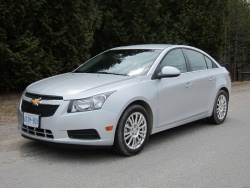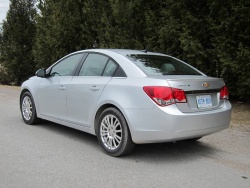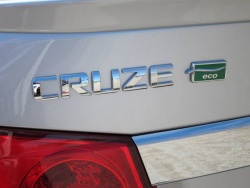 2011 Chevrolet Cruze Eco. Click image to enlarge |
|
Related links
Manufacturer’s web site |
Review and photos by Jil McIntosh
Photo Gallery:
2011 Chevrolet Cruze
Toronto, Ontario – Gas prices have certainly taken a turn for the worse recently, and it’s entirely possible that, as the saying goes, “you ain’t seen nothin’ yet.” One solution to ease the pain, and one that may become even more prominent in future, is fuel-miserly versions of some existing automaker’s models. At Chevrolet, that’s the Cruze Eco, which I drove on a day-long event north and east of Toronto.
Through a mixture of aerodynamic tweaks and powertrain modifications, the engineers were able to bring the Eco’s published fuel figures down to 7.2 L/100 km (39 mpg Imp) in the city and 4.6 (61) on the highway with the six-speed manual transmission, and 7.8 (36) city and 5.1 (55) highway with the six-speed automatic. That 4.6 on the highway is equal to some hybrids, the company says. By comparison, the non-Eco Cruze LT and LTZ models, which come only with an automatic, are rated at 8.5 (33) in the city and 5.5 (51) on the highway.
  2011 Chevrolet Cruze Eco. Click image to enlarge |
The Cruze starts with a base LS trim level that uses a naturally-aspirated 1.8-litre four-cylinder. At $14,995 with manual transmission it’s a low buy-in, but its engine is less powerful and thirstier than the powerplant used in the other trim lines. Those are led by the Eco, followed by the LT and LTZ, all of which use a turbocharged 1.4-litre four-cylinder making 138 horsepower and 148 lb-ft of torque. The forced-air system isn’t for go-fast performance, but to provide larger-displacement power with smaller-engine fuel figures. It also runs on regular-grade gasoline. The Eco can be optioned with a six-speed automatic that’s the only gearbox choice in the LT and LTZ, but the default transmission, and the one I drove throughout the day, is an Eco-specific six-speed manual whose three top gears are overdrive. To further get the petrol-pinching principle across, sixth gear is marked on the gearshift knob with a little green circle.
Pricing for the Eco commences at $19,495 with the stick shift; add another $1,450 for the autobox. The entry price is the same as for the LT trim line, which comes only with an automatic, and which is equipped fairly the same as far as features go. Paul Hewitt, GM’s product manager for the Cruze, says the pricing pretty much matches up when you consider the cost of the aerodynamic improvements on the Eco versus the standard-equipment automatic transmission on the LT. The Eco includes such items as lightweight 17-inch alloy wheels with low-rolling-resistance tires, air conditioning, ten airbags including front knee and rear seat sides, electronic stability control, heated mirrors, variable intermittent wipers, cruise control, auto-dimming rear-view mirror, tilt and telescopic steering wheel, satellite radio and express-down windows, with express-up for the driver as well.
   2011 Chevrolet Cruze Eco. Click image to enlarge |
You can’t option the Eco into a top-line LTZ, but there are a few add-ons available, such as a connectivity package that includes Bluetooth and OnStar, fog lamps, tire pressure monitoring system, premium stereo and a real head-scratcher, a set of illuminated sill plates for $490, should the unlit $150 ones not be to your taste. The Eco with automatic can also be optioned with a remote starter, which doesn’t really seem to make sense given that idling wastes fuel. Still, GM says that many people want them and the company prefers to make a factory-installed one available, rather than deal with customer complaints should aftermarket installers do a poor job of tapping into the vehicle’s wiring system.
There are several fuel-saving tricks on board, but by far the most important is a set of electronic air shutters tucked in behind the lower grille. Made of high-strength plastic, and protected from road debris by the grille, the shutters operate similarly to the way a Venetian blind works. The system uses several sensors that determine such factors as vehicle speed, engine temperature and ambient temperature, keeping the shutters open when maximum airflow is required and then closing them to reduce drag at higher speeds. They also help to warm up the engine faster, bringing it to the optimum temperature quickly for maximum efficiency. They stay closed in freezing weather so there’s no danger of them attempting to open while they’re frozen shut. Hewitt says that of the ten per cent aerodynamic advantage that the Eco has over its siblings, over half is attributable to the shutters. They’ll be showing up on some other models in future, including the upcoming redesigned Malibu.
Other items that help reduce drag are Eco-specific underbody panels, a slightly lower suspension, the lightweight wheels, front and rear tire blockers, extensions in the wheel well liners, modified grille and the low rolling resistance tires. At 1,365 kilograms, it’s 97 kilos lighter than the LT model (it’s actually the slimmest Cruze model, undercutting the base LS by 21 kilos). It was a case of shaving wherever possible: the hundreds of weld flanges on the body are reduced by a millimetre, and in select components, sheet metal gauge thickness was reduced by about 0.1 millimetre where it wouldn’t affect the structural integrity. It also uses a tire sealant and inflation kit in place of the compact spare found in the other models (the doughnut tire can be optioned on the Eco if desired). They’re small steps individually, but it all adds up.
   2011 Chevrolet Cruze Eco. Click image to enlarge |
Out on the highway, the Eco did itself proud. The Cruze overall is one of the best compact sedans on the market right now, and for all its fuel-miserly ways, it doesn’t feel much different than the LT that I drove as a test vehicle. The clutch and shifter combination are smooth, and the engine is peppy on acceleration as well as fairly quiet. The instrument cluster includes an upshift light, which I followed fairly obediently to see how it all came together. The overdrive gears worked great on flat ground. When I got into some rolling terrain, I found that I was downshifting quite a bit even on gentle hills, since it didn’t take long for the engine to run out of puff when in fifth or sixth gear. I’m guessing the automatic version downshifts a fair bit on hills as well, although I didn’t have a chance to drive one.
Both my driving partner and I used a light foot, but we also made sure we didn’t hold up traffic on our route, which was primarily rural back roads and highway with a little bit of city traffic thrown in. We didn’t have the opportunity for a true mileage check, but in lieu of that, we consulted the car’s trip computer, which showed an average of 5.6 L/100 km (50 mpg) for the day. Of course, mileage will vary widely in the real world, depending on driving habits, weather and many other factors.
Thanks to its roomy interior and extremely quiet cabin, the Cruze feels bigger than it is, and it rides more like a midsize than a compact. An unusual feature for the segment is its rear suspension. Known as a Z-link or Watts link, it uses horizontal bars on a central pivot that help keep the rear centred and reduce wheel hop on rough pavement. It works extremely well, as I discovered on an earlier event at GM’s proving grounds in Michigan; equipped with the link, the car held steady on an intentionally poor stretch of road at 100 km/h where its competitors made me lose my nerve at about 80 km/h. But there is a catch: the Eco with automatic transmission uses the Watts link, while the Eco with stick shift does not. Why not? Surprisingly, GM’s rep said he didn’t know, and so the mystery remains.
The LT trim line is pegged as the Cruze’s volume seller. GM initially expected a take rate of about ten per cent for the Eco, “but that was our original prediction, and gas was a dollar a litre then,” Hewitt said. While it is the entry-level for the turbocharged four-cylinder, it isn’t a bottom-of-the-line model, and it’s possible that the company’s initial predictions will go much higher when buyers spot the gas station signs on the way to the dealership. Short of staying home, it’s a step toward keeping just a little more money in the pocket rather than giving it over to the pump











